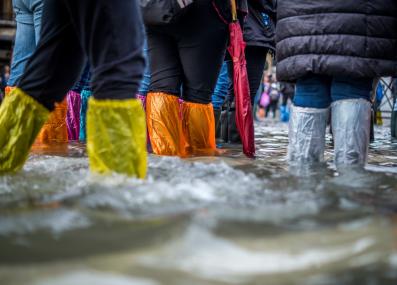Have a question?
Why isn’t sea level rise the same everywhere?
Thanks to shifting currents, groundwater pumping, and even ancient ice sheets, a community can experience a rate of sea level change that’s very different from the global average.
June 20, 2025
As humans pump climate-warming pollution into the air, heating up the atmosphere and oceans and melting vast tracts of ice, global sea level is rising. Averaged over the whole planet, the oceans are already more than 20 centimeters (roughly eight inches) higher than they were in 1900. And the rise is speeding up: Sea level climbed nearly twice as fast from 2006 to 2018 as it did in the several decades prior.1
But this global average doesn’t tell us how rising seas will affect people’s lives. As a result of many processes—from shifts in ocean currents to sinking of the land—different areas face different rates of sea level change. Some places, like Galveston, Texas, have seen the water rise far faster than the global average—by over two feet since 1904.2 In other places, sea level has risen more slowly. There are even places, like parts of Alaska, where sea level is falling.3
These local changes are what matter most for people, says Sarah Das, an associate scientist at the Woods Hole Oceanographic Institution. “What you experience is the impact of sea level rise on your community, your economy, your safety,” she says. Rising seas are already leaving their mark—magnifying hurricane damage4 and plaguing cities with more flooding at high tide5—with worse impacts on the way. To prepare for those impacts, you need to know “what sea level is doing in your backyard.”
Globally, sea level rise has two main culprits. For one, Das says, the ocean is doing a “heroic job” of absorbing the vast majority of the extra heat trapped by our climate pollution. As it warms, the water expands, driving up global sea level. On top of that, the warming atmosphere and oceans are melting ice sheets and glaciers, dumping enormous amounts of water into the sea.
But when ice melts into the ocean, the effect isn’t as straightforward as filling a bucket with a hose. For example, the ice sheets of Antarctica and Greenland exert their own gravitational pull on the ocean around them. “That knowledge really forces you to try to get your head around exactly how massive these ice sheets are,” Das says.
When an ice sheet loses mass, that pull weakens, and water moves away. That means (all else being equal) sea levels rise more in places farther from the melting ice sheet.6
This effect helps give each ice sheet a unique pattern, or “fingerprint,” of sea level change as it melts. As a result, melting ice in Antarctica has a bigger effect on the northeastern United States than melting a similar amount in Greenland.7
Shifts in the circulation of Earth’s atmosphere and in ocean currents can also fuel local changes in sea level. These shifts can redistribute seawater, causing sea level to rise in one area and dip in another. For example, strong trade winds in the Pacific Ocean normally push warm water westward, meaning seas sit higher off of places like Papua New Guinea in the western Pacific, and lower off of regions like the U.S. west coast. But natural weather patterns like El Niño, which appears irregularly every few years, can dampen those trade winds and let warm water move east. For places like California, sea level rise is sometimes magnified (like during El Niño years), and sometimes muted.8
There’s another wrinkle, too. “Land moves up and down. It moves on short timescales, long timescales. It moves smoothly; it moves erratically,” Das says. This motion means some places are dealing not only with rising seas, but also with falling land. In American Samoa, sinking land in the aftermath of a 2009 earthquake has driven sea level rise much faster than the global average.9 Human activity, like pumping out groundwater or oil and gas, can also cause the land to sag. Parts of coastal Louisiana and Texas saw a lot of this kind of fluid extraction in the mid-to-late 20th century, contributing to the region’s swift sea level rise.2, 10
In Earth’s land movement, we can also see the ghosts of ice sheets past. During the peak of the last ice age, around 20,000 years ago, sprawling ice sheets covered far more of the planet’s surface. This ice, over two miles thick in places, pressed down the land beneath it, while pushing up the Earth’s crust in the surrounding areas. (Imagine sitting on a mattress; beneath you, the mattress will sink, and around you, it will bulge upwards a bit.11) The Earth is still adjusting from the loss of so much ice, Das says. Gradually, the land that was underneath the vanished ice sheets is moving up, and the nearby bulges are collapsing.
In the Chesapeake Bay region, this process is causing land to sink and helping fuel faster-than-average sea level rise. Norfolk, Virginia, home to the world’s largest naval complex, has seen sea level climb a full foot since 1970.12 Meanwhile, Canada’s Hudson Bay has experienced sea level fall, as formerly ice-covered land rebounds.13
“None of these things are acting in isolation,” Das adds. They’re also not happening on the same timescales; relative sea level is affected by shorter-term shifts in ocean currents and the slow relaxation of the Earth’s crust. Which processes matter most depends on not only where you are, but whether you’re planning for the next two years or the next 200.14
The risks posed by rising seas are molded by all these overlapping processes—and many others. For example, while sea level rise has made high-tide flooding worse in the U.S.,15 researchers have found that the exact relationship differs from place to place. In some areas, like off the Gulf of Maine, because of the way the tides behave, seas don’t need to rise all that much to cause a big spike in flooding.5 Risks also depend on human factors, like how many people live near the coast, or whether critical infrastructure such as hospitals and airports are in the flood zone.
All these close-to-home variables matter as communities figure out how to adapt to higher seas—whether by building sea walls, restoring protective salt marshes, or helping people move away from the coast. And by curbing our climate pollution and slowing the rising seas, Das adds, we can buy ourselves more time to make these decisions. “If you had 20 more years to be resilient and adapt, that’s enormous.”
Submit your own question to Ask MIT Climate
1 Gulev, Sergey K., et al. "Changing state of the climate system." (2021). In Masson-Delmotte, Valérie, et al (Eds.), Climate Change 2021: The Physical Science Basis. Contribution of Working Group I to the Sixth Assessment Report of the Intergovernmental Panel on Climate Change (pp. 287-422). https://doi.org/10.1017/9781009157896.004.
2 Liu, Yi, et al. "Land subsidence contributions to relative sea level rise at tide gauge Galveston Pier 21, Texas." Scientific Reports 10 (2020). https://doi.org/10.1038/s41598-020-74696-4.
3 Lindsey, Rebecca, et al. National Oceanic and Atmospheric Administration. "Interactive map: How has local sea level in the United States changed over time?" (December 20, 2021). Accessed June 2025.
4 Strauss, Benjamin H., et al. "Economic damages from Hurricane Sandy attributable to sea level rise caused by anthropogenic climate change." Nature Communications 12 (2021). https://doi.org/10.1038/s41467-021-22838-1.
5 Sun, Qiang, et al. "Causes of accelerated high-tide flooding in the U.S. since 1950." npj Climate and Atmospheric Science 6 (2023). https://doi.org/10.1038/s41612-023-00538-5.
6 Mitrovica, Jerry X., et al. "All sea level is local." Bulletin of the Atomic Scientists 74 (2018). https://doi.org/10.1080/00963402.2018.1461935.
7 Sweet, William V., et al. National Oceanic and Atmospheric Administration. Global and Regional Sea Level Rise Scenarios for the United States: Updated Mean Projections and Extreme Water Level Probabilities Along U.S. Coastlines. (2022).
8 Hamlington, Benjamin D., et al. "Past, present, and future Pacific sea-level change." Earth's Future 9 (2020). https://doi.org/10.1029/2020EF001839.
9 Han, Shin-Chan, et al. "Sea level rise in the Samoan Islands escalated by viscoelastic relaxation after the 2009 Samoa-Tonga Earthquake." JGR Solid Earth 124 (2019). https://doi.org/10.1029/2018JB017110; Huang, Stacey A., et al. "Spatiotemporal patterns of subsidence and sea level rise in the Samoan Islands 15 years after the 2009 Samoa-Tonga Earthquake." JGR Solid Earth 130 (2025). https://doi.org/10.1029/2024JB029765.
10 Kolker, Alexander S., et al. "An evaluation of subsidence rates and sea-level variability in the northern Gulf of Mexico." Geophysical Research Letters 38 (2011). https://doi.org/10.1029/2011GL049458.
11 National Oceanic and Atmospheric Administration. "What is glacial isostatic adjustment?" (Updated June 16, 2024). Accessed June 2025.
12 U.S. Global Change Research Program. U.S. Sea Level Change: National Sea Level Explorer. "Sewells Point." (Updated December 1, 2024). Accessed June 2025.
13 Hayden, Anna-Mireilla, et al. "Multi-century impacts of ice sheet retreat on sea level and ocean tides in Hudson Bay." JGR Oceans 125 (2020). https://doi.org/10.1029/2019JC015104.
14 Hamlington, Benjamin D., et al. "Understanding of contemporary regional sea-level change and the implications for the future." Reviews of Geophysics 58 (2020). https://doi.org/10.1029/2019RG000672.
15 Piecuch, Christopher G., et al. "Impact-based thresholds for investigation of high-tide flooding in the United States." Earth's Future 13 (2025). https://doi.org/10.1029/2024EF005850.









